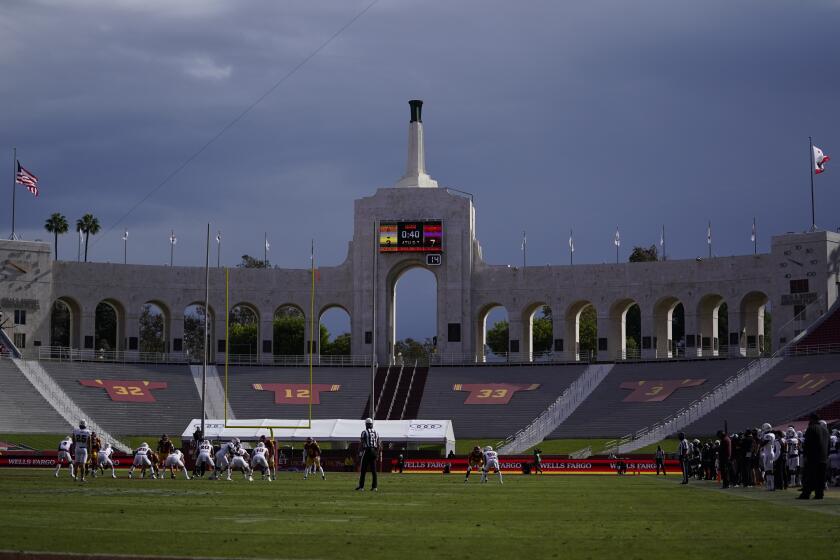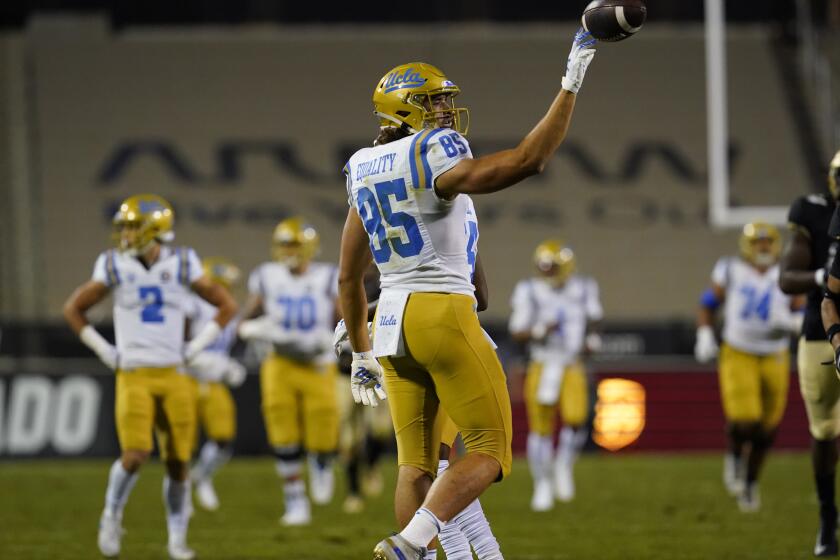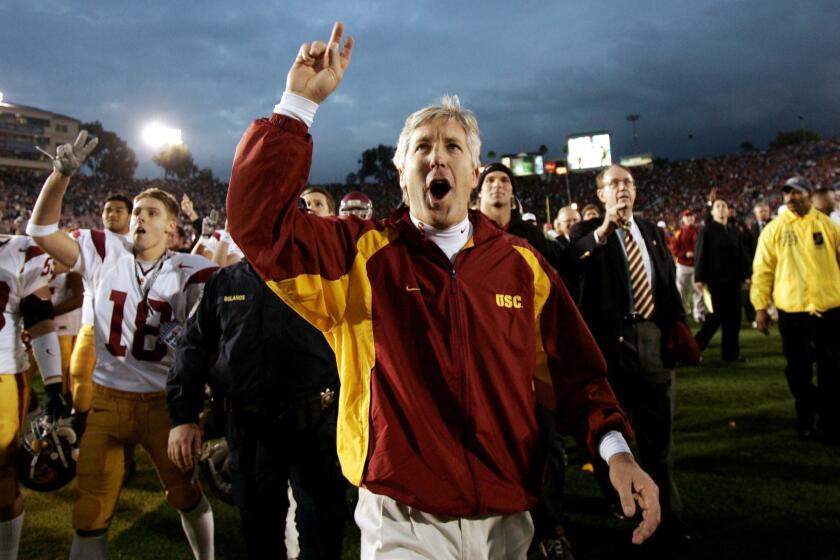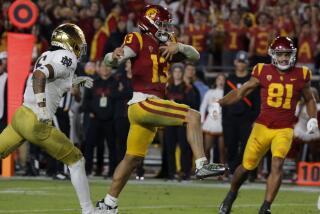A Notre Dame celebration was reckless, but can it teach us about COVID-19 spread?
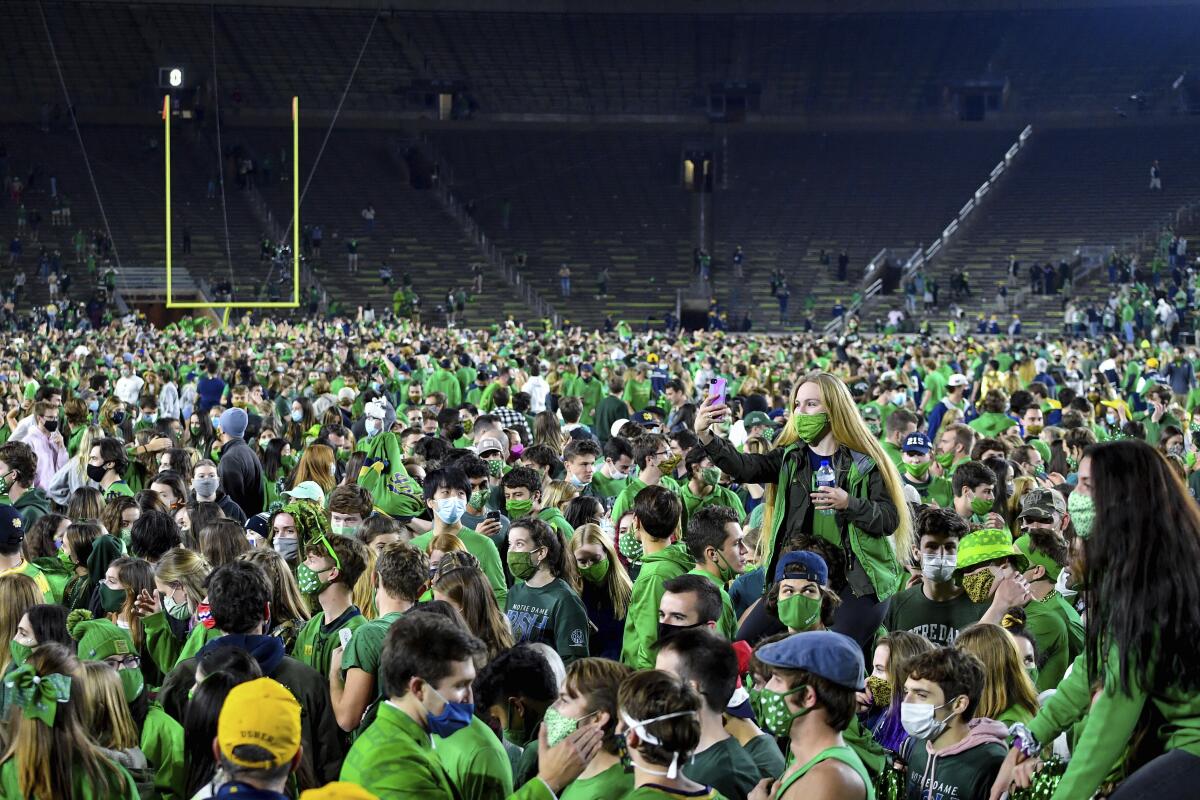
- Share via
Fans began to abandon their seats at Notre Dame Stadium near the end of the fourth quarter, shuffling toward the field as if drawn by magnetic attraction. The crowd — mostly students, once sitting in socially distanced intervals throughout the stands — soon congealed, shoulder-to-shoulder, in the first few rows.
Their football team was staging an improbable comeback against top-ranked Clemson and everyone wanted to be near the action. There was an electricity, a tension that was unleashed when the fourth-ranked Irish won in double-overtime. It was the school’s first win over a No. 1 team in 27 years.
“You saw a couple kids jump onto the field,” said John Esposito, a senior at the university. “After that, the flood gates opened.”
National television showed thousands of students swarming onto the turf. The celebration was familiar to fans of college football but, in a time of pandemic, it was troubling as well. A local health official at the stadium that night watched in dismay.
“A lot of hugging and high-fiving and screaming,” said Mark Fox, deputy health officer for St. Joseph County (Ind.). “From a public health standpoint, it’s not what I would recommend.”
The scene last Saturday in many ways encapsulated a worrisome football season, with the novel coronavirus sidelining star players and forcing games to be postponed each week. There was widespread pushback and opprobrium on social media.
A look at college football games postponed or canceled because of COVID-19.
“I can understand why people would be upset,” said Brandon Hardy, a recent graduate who returned for the game. “It was one of those things where you make a decision in the moment.”
But as the days pass and the furor subsides, infectious disease experts see a potential silver lining. They wonder if some good may come from what transpired in South Bend.
::
Football wasn’t the only cause for spontaneous celebration last weekend as the announcement of Joe Biden’s victory in the presidential election sparked mass gatherings in cities across the country. But the situation at Notre Dame was different.
The nation’s future was not at stake. And university administrators had advance warning that emotions might spill over.
The Clemson-Notre Dame game was more than just a matchup of top-5 teams; it was the final home game before students depart for a winter break that will extend until February. Athletic director Jack Swarbrick posted a video message beforehand.
“We will have millions tuning in around the country to watch this game,” he said. “Let’s show how the best student fans in the country support their team with class and passion.”
Students required a negative test result earlier in the week to receive a ticket and were reminded to wear masks to the stadium. School traditions were altered: Seniors attending their final game would have to forgo the joyous ritual of throwing marshmallows around the stands and wait until both teams exited before taking a customary photo on the field. The university assigned extra staff to keep everyone in line.
“Be smart,” Swarbrick said. “Be safe.”
The stadium was limited to about 14% of its capacity, with 11,011 spectators dispersed in small, carefully spaced groups, but there was reason to suspect that students might disregard protocol.
Though the university had suffered a campus-wide outbreak earlier in the semester, its president, Rev. John I. Jenkins, attended a controversial White House ceremony in October at which guests sat close together with few wearing masks. In the wake of the event, announcing the nomination of Judge Amy Coney Barrett to the U.S. Supreme Court, Jenkins and others tested positive, eliciting anger at a Catholic school that claims to hold itself to high standards.
“Our president broke the rules,” senior Samantha Munson said. “There have been so many jokes about him … I don’t know if anyone cares about his opinion.”
Though marshmallows were a rarity on Saturday, other signs of trouble arose after the game began, notably bands of students who departed their pre-arranged groups to move freely about the stands.
“The ushers tried their best to tell people to go back to their seats,” Esposito said, “but people kind of clumped together.”
An expanding crowd, clad mostly in green, had formed at one end of the stadium by the time a Notre Dame touchdown tied the score, 33-33, in the final minute of regulation. By then, other students had made their way down to the brick wall that separates the stands from the field.
The excitement — and the horde — continued to swell as both teams exchanged touchdowns in the first overtime. Munson heard talk of storming the field if the Irish won.
“I could hear guys yelling it,” she said. “It got so much louder and kids started inching forward.”
Notre Dame fans and students rush the field after victory over Clemson on Saturday.
On the turf below, ushers and police formed a loose ring around the field, but it was obvious there weren’t enough of them.
“We were a mob,” student Keleb Mehari said. “They just couldn’t stop us.”
::
Unlike the NBA and NHL, college football did not return to action in a bubble. Unlike early golf tournaments and regular-season baseball, some college games have welcomed spectators in limited numbers.
As a result, scores of athletes have been infected and more than 50 games have been postponed or canceled. The Southeastern Conference called off its four biggest matchups this weekend, including the Alabama-LSU game. An unidentified player required hospitalization at Utah, a team hit so hard by the virus that its scheduled visit to UCLA on Saturday also had to be canceled. The Pac-12 entered this weekend having cancelled as many football games as it had played (four).
Clemson quarterback Trevor Lawrence served as a highly visible reminder of the crisis last weekend, pacing the sideline in a mask, unable to play after testing positive in October. Though no longer contagious, he had not completed the required cardiac tests to rule out long-term health effects.
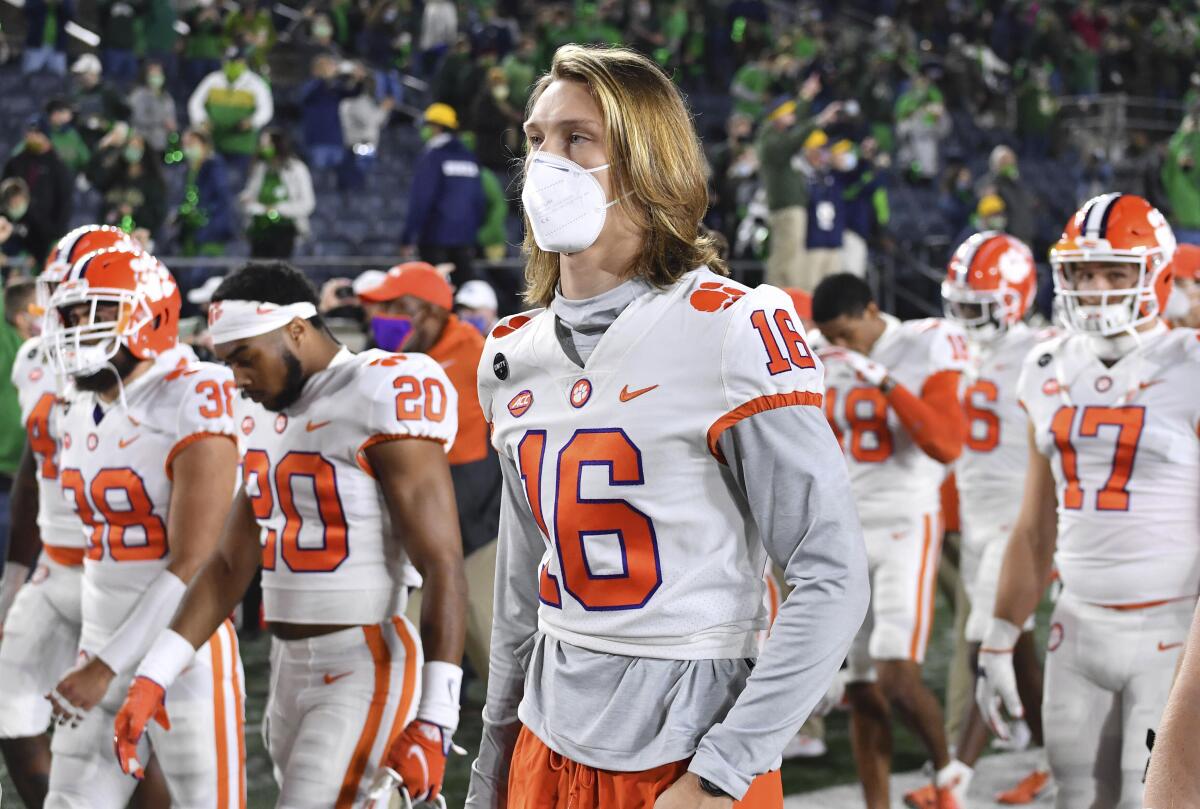
Lawrence and his teammates hurried off the field at game’s end, doing their best to avoid the onrushing crowd. Dr. David Eisenman, director of UCLA’s Center for Public Health and Disasters, saw clips on television.
“All those people crowded together, cheering and yelling,” he said. “It made me nervous, for sure.”
Eisenman understands there are no easy answers to living with the novel coronavirus. He recalled the early days of the HIV/AIDS pandemic, when public health officials unsuccessfully preached abstinence. Only later, when promoting safe sex, did they see a reduction in cases.
“We need to have the same principle in mind here,” he said. “We do need to be able to celebrate. We do need to be able to gather.”
Eisenman is talking about safe practices such as wearing masks, social distancing and limiting gatherings to small groups. If anything, he faults Notre Dame for allowing so many people into the stadium. But he and others hope the postgame celebration can serve as a lesson.
Given the rising case numbers in St. Joseph County, officials expect that at least some fans at the game were infected. The university had previously planned to test all students early this week in anticipation of winter break; those tests were delayed until Thursday to allow for cases that might develop from the Clemson game.
In this way, Saturday night might help researchers better understand the dynamics of coronavirus transmission in mass, outdoor settings.
UCLA’s home opener against Utah scheduled for Saturday at the Rose Bowl was called off Friday because of COVID-19 issues involving the Utes.
A Stanford team recently used statistical methods to link more than 30,000 additional cases and at least 700 additional deaths to 18 of President Trump’s reelection rallies, but additional scientific literature related to protests and marches has been largely scattered and inconclusive. Now experts have the potential for a natural scientific experiment with a large, identifiable sample to examine.
“We need this kind of information,” Eisenman said. “If you see a huge spike, that tells you something. If you don’t, that tells you something else.”
St. Joseph County officials plan to work with the university to conduct contact tracing on students who test positive, searching for clues as to their movements last weekend. Experts say it will take significant effort to capture necessary details: Did the infected students wear masks on the field? Did they attend one of the parties that sprang up around campus later?
“You need to know a lot,” said Dr. Larry Chang, an infectious disease specialist at Johns Hopkins University School of Medicine. “It’s a difficult thing to do.”
Chang hopes that college football will learn from the Notre Dame game when it comes to allowing thousands of spectators into stadiums.
“You have to create structural situations where you minimize incidents like this,” he said. “We can’t rely on individual students to make the right decisions.”
::
Notre Dame students knew there could be a lag in testing, that a negative result several days before the game could not guarantee they would be uninfected at the stadium. Still, they wore masks and felt safe.
“A lot of people have confidence in the protocols,” Munson said. “I wasn’t worried at all.”
Any hesitance about rushing the field evaporated the moment the Irish secured a 47-40 victory. When administrators saw the crush of bodies, they quickly radioed staff to let the students spill out of the stands.
“We were afraid people might be hurt or injured in the rush,” said Paul Browne, vice president for public affairs and communications. “You could say we called an audible.”
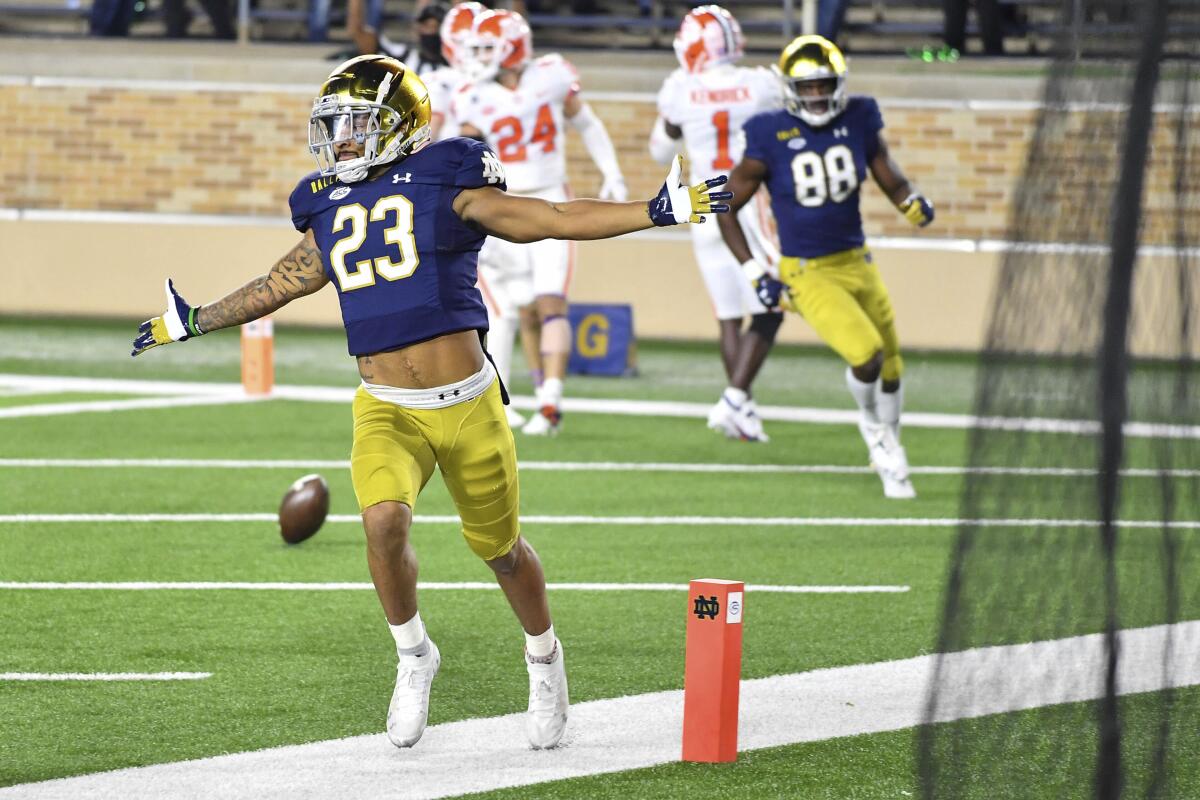
Blue-jacketed ushers could be seen waving futilely or merely stepping aside as fans poured over the shoulder-high wall in waves, leaping to ground and sprinting toward the center of the field.
“It was kind of a far drop but I didn’t even feel it,” Esposito said. “It was like walking on air.”
Notre Dame coach Brian Kelly had warned his players in advance, telling them to head for the locker room if they won, but there was no avoiding the throng that, by most estimates, lingered for 15 to 30 minutes as loudspeakers blared, imploring fans to exit the venue.
The next day, Jenkins, the university president, issued an angry letter that focused on the risks posed by the parties rather than the game. Students were threatened with “severe sanctions” for future misbehavior and told that next semester’s registration would be put on hold if they failed to take a coronavirus test before departing for the semester.
Former USC and current Seattle coach Pete Carroll speaks about the last 20 years and what comes next.
Munson got a worried call from her parents, who asked: “What were you doing?”
Like other students interviewed, the senior expressed no regrets. Football is a very big deal at Notre Dame and she explained to her family that the Clemson game now ranks among the highlights of her college career.
“I think my dad got it,” she said. “I don’t know if my mom did.”
In the days since the game, the Irish players have been tested four times; there were no positive results as of Friday evening. With his team now ranked second in the nation and scheduled to play at Boston College on Saturday, Kelly said he does not spend much time worrying about infections.
“But the virus is as the virus is, right?” he told reporters. “It’s out there and you never know.”
Mia Berry contributed to this story.
More to Read
Go beyond the scoreboard
Get the latest on L.A.'s teams in the daily Sports Report newsletter.
You may occasionally receive promotional content from the Los Angeles Times.

